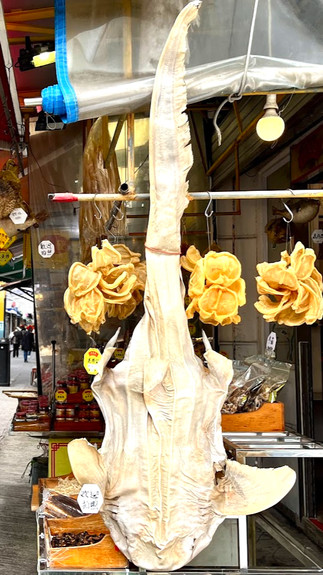Tao O Ancient Fishing Village
- shan157
- Apr 20
- 4 min read
Updated: Jul 30
Discover the Forgotten Village at the Edge of Hong Kong
Tao O Fishing Village, perched quietly on the far western edge of Lantau Island, offers one of Hong Kong’s most striking contrasts, a peaceful, slow paced enclave framed by forested hills and tidal inlets, far removed from the high rise skyline and urban rush. With roots dating back over 200 years, the village is thought to have been founded during the Qing Dynasty by Hakka and Tanka fishing families. Drawn by the bay’s rich marine life and protected coastline, these early settlers built simple homes on wooden stilts above the water, a practical and symbolic adaptation to life by the sea. Today, these iconic pang uk (modest stilt houses) still line the narrow creeks, bearing witness to a way of life shaped by tide, weather and tradition.

For generations, Tao O sustained itself through fishing, seaweed harvesting and small scale aquaculture. Before refrigeration or outside trade, villagers relied on techniques passed down through oral tradition, like drying, salting and fermenting seafood to preserve the catch. Dried shrimp, cuttlefish and salted fish became not just food staples but also trade goods with nearby settlements. Even as industrial fishing and tourism changed the economic dynamics of Lantau Island, Tao O retained its practical self sufficiency. Some villagers still go out in small wooden boats, maintaining fish pens or drying their catch in the open air. The lifestyle may be quieter now but it’s rooted in resilience, with many residents also growing herbs, vegetables and fruit in modest home gardens.
Spiritual life runs deep in Tao O and the sea governs more than just the economy, it shapes the village’s belief systems. Temples and shrines, often small and weathered by time, are dedicated to deities like Tin Hau, the revered goddess of the sea, who is believed to protect fishermen and guide them home safely. The annual Tin Hau Festival, held on the 23rd day of the third Chinese lunar month, is a major event in the village, drawing locals and visitors alike. It features colourful rituals, dragon dances, seafood offerings and the ceremonial blessing of boats. These traditions are more than just festive displays, they reinforce community ties, express gratitude to the natural world and keep alive the village’s cultural identity in the face of increasing modernisation.

Tao O’s mystique is deepened by the folktales that ripple through its history. One of the village’s most enduring legends tells of a dragon that once inhabited the bay, guarding Tao O from storms and pirates. To honour this mythical protector, villagers are said to have erected small shrines along the waterfront. Another tale speaks of the rare sighting of a “white dolphin,” considered an omen of good fortune and transformation. These stories, whether passed around kitchen tables or whispered among elders, reflect the village’s intimate relationship with nature, as well as its respect for unseen forces that shape life along the coast.
Despite its remote location, Tao O has gained quiet popularity among travellers seeking something different from the urban norm. The journey itself, whether by bus, cable car or foot, feels like a passage into another era. Visitors are drawn by the village’s humble beauty, its laundry swaying on bamboo poles, seafood drying on racks and wooden boats bobbing beside homes built over water. Walking through its narrow lanes, one gets the sense of a place suspended in time. Tourists often photograph the stilt houses, sample dried seafood snacks and chat with long time residents, who share stories that don't appear in guidebooks.

Though urban development continues to edge closer to Lantau Island, Tao O remains one of the few places in Hong Kong where tradition is not just preserved but lived. It is a place where the pace of life mirrors the rise and fall of the tides and where modern visitors can still connect with the rhythms of a vanishing past. In Tao O Ancient Fishing Village, history is not sealed in a museum, it breathes through its wooden beams, salty breezes and the quiet voices of those who call it home.
🗺️ Location
Tat Tung Road, Tung Chung, Hong Kong, China
🚆 How to get there
Getting to Tao O Fishing Village from central Hong Kong is easy and scenic. Start by taking the MTR Tung Chung Line to Tung Chung Station (about 35 minutes). From there, walk to the nearby bus terminus and take Bus 11 to Tai O, which takes around an hour. For a more scenic route, take the Ngong Ping 360 cable car from Tung Chung to Ngong Ping Village, then transfer to Bus 21 to Tai O. Once you arrive at the bus terminus, the village is just a short walk away. Or you could organise an all inclusive day tour from Hong Kong for around $380HK, which includes the Big Buddha and the Ngong Ping cable car.
⭐ Attraction Info
Tai O Fishing Village is open to visitors 24 hours a day, with no admission fee. While the village itself is always open, specific attractions like boat tours and the Tai O Heritage Hotel may have their own operating hours and fees. It's advisable to visit during daylight hours to fully appreciate the views and experience the local shops while they're open. For budget-friendly options, local boat tours around Tai O's stilt houses are available for approximately HK$40 per person.



















